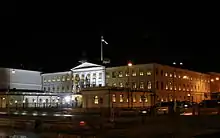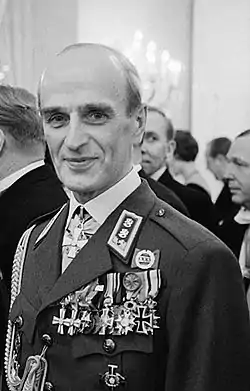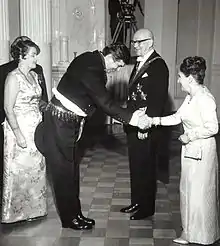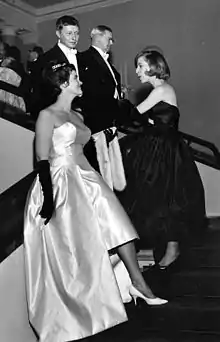Independence Day Reception (Finland)
The Independence Day Reception (Finnish: Itsenäisyyspäivän vastaanotto) is an annual event organised by the President of Finland at the Presidential Palace in Helsinki on 6 December, Finland's Independence Day. Invitations are sent to all members of parliament and other representatives of the national and municipal governments, the ambassadors to Finland, representatives of NGOs, important business people, and people who distinguished themselves during the year in the arts, sports, sciences, and other fields.

History
Growing tradition
The tradition of Independence Day Receptions began after Finnish Independence in 1919. The first afternoon reception was hosted by president K. J. Ståhlberg his daughter Aino Ståhlberg. The reception had approximately hundred and fifty guests and lasted for an hour. Guests were offered coffee and refreshments in the Gothic hall in the Presidential Palace.
The first evening reception was hosted by and Ståhlberg and his wife in 1922, when the ceremony also included traditional presidential greeting of guests, and dance. Serving of alcohol at the event started after the abolition of the Finnish prohibition law in 1934. During the reign of president Kyösti Kallio in 1937 and 1938 there was no dancing or serving of alcohol due to prevailing religious beliefs. In the era of president J. K. Paasikivi serving of punch was started. Short films were made about the reception to be shown in movie theatres before the main feature.
Reporters were let to cover the reception for the first time in 1949. The first live television broadcast from the reception was sent in 1967.[1]
Due to the influence of president Urho Kekkonen's wife Sylvi artists and writers were invited to the reception in 1966, with whom she had discussions in the Yellow salon. At largest there were up to 2300 guests participating to the Independence Day Reception. In 1968 the speciality at the reception was letkajenkka.[2] The public was especially interested in with whom the recently widowed president Kekkonen danced with in the 1978 reception (Satu Östring-Procopé).[3]
After Mauno Koivisto became the president of republic in 1982 the event was once more hosted by a presidential couple and also their daughter, 'the princess of the republic', Assi Koivisto, who started a Chicken Dance at the reception. Tellervo Koivisto, the wife of president Koivisto, would have changed the reception back to an afternoon coffee event but eventually gave up after facing strong resistance.
During the era of president Martti Ahtisaari jazz was brought to the Yellow salon, and salty snacks, regional dishes and wines were added to the menu.
The years without reception
In the young republic neither the presidential institution nor the independence day reception were not yet traditionalised at the beginning of the 1930s. Example of this is that in the year 1931 the reception was not held due to the 70th birthday of president P. E. Svinhufvud happening in the same month. In 1932 the reception was skipped due to the state visit of the Swedish crown prince. The reception in 1933 during the Great Depression was cancelled due to the lack of ingredients needed for preparing the banquet, which also could be taken as show of solidarity to the general public struggling with the times. The longest break in the tradition came with the World War II when the reception was not held for seven years 1939 - 1945. Thus presidents Risto Ryti and Gustaf Mannerheim never got to host the event in the Presidential Palace.
The Independence Day Reception was not held in the presidential palace:
- 1926 President Lauri Kristian Relander was ill[4]
- 1931 President Pehr Evind Svinhufvud had his 70th birthday on December 15
- 1932 The state visit of Swedish crown prince Gustaf Adolf
- 1933 Economic depression
- 1939 Winter War
- 1940 President Kyösti Kallio was ill[5]
- 1941–1942 Continuation War
- 1943 The reception was held in the Fire department at the City of Turku by president Risto Ryti, the first time in the history of independent Finland when the reception was held outside Helsinki.[6]
- 1944 Lapland War
- 1945 President Gustaf Mannerheim was ill[7]
- 1952 President J. K. Paasikivi was ill
- 1972 Due to the refurbishment of the Presidential Palace the reception was held in the Finlandia Hall by the prime minister Kalevi Sorsa. President Urho Kekkonen was in attendance.
- 1974 President Urho Kekkonen's spouse Sylvi Kekkonen died on 2 December.
- 1981 President Urho Kekkonen was ill: the reception was held in Finlandia Hall hosted by the Internal minister Eino Uusitalo , as the Prime Minister Mauno Koivisto was the acting president at the moment.
- 2013 Refurbishment of the Presidential Palace: Independence Day Concert and Reception (without the dance) was held at Tampere Hall,[8] the second time in the history of independent Finland when the reception was held outside Helsinki.
- 2020 Independence Day to be celebrated remotely because of coronavirus restrictions.Instead of a reception, a television broadcast from the Presidential Palace and from all over Finland.[9]
Invitees

On average about 1800 guests are invited to the Independence Day Reception. Some are invited due to their status: yearly invites are sent to the members of the Council of State, Members of parliament, Diplomats, bishops, Finnish members of the European parliament, chancellors and rectors of Finnish Universities, generals and the most senior officials of the Judiciary. Former presidents, prime ministers and speakers of the parliament are also among regular invitees. President Martti Ahtisaari began the tradition of inviting all Knights of the Mannerheim cross, who had previously been summoned to the reception by president Koivisto in 1987. The invites to the senior state officials rotate so that invitations are sent every second or third year.[10]
Each year approximately a third of the guests receive their first invite to the event. It has been a custom to invite the most prominent members of business and cultural life. The number of performing artists increased during the era of president Tarja Halonen.
In 2009 the invitations were embedded with a microchip due to safety concerns, which includes the identification of the invitee according to the statement from the office of the president.[11]
The dress code for the occasion is very festive in the spirit of White Tie event: the invitees are instructed to wear "tailcoat and dress suit". Medallions of Honor can be held in the original size. Men can use a dark suit - but not a tuxedo − instead of a tailcoat; for women the "evening dress" means a full-length gown made from a festive material accompanied with jewellery.[12][13] Artists have been given more leeway in following the dress code. Priests and officials of police and other branches arrive in the related festive suits.
Both men and women can dress in the traditional folk costume if they so choose. According to experts it is the best option for the occasion, as it fits the etiquette and also emphasises Finlands national identity.[14]
The invitees to the Independence Day Reception are supposed to appear unless not able to participate.
The ceremony

Traditionally all guests greet the president personally when entering the event. The first guests - war veterans - enter from the Mariankatu entrance accompanied by the sounds of Jäger March by Jean Sibelius. The first to greet the president are the Knights of the Mannerheim cross. Between 1994 - 2000 the first guest to enter the Palace was General of Infantry Adolf Ehrnrooth. Years 2001 - 2007 the proceeding was headed by Captain Pentti Iisalo. Captain Tuomas Gerdt was on point years 2008 - 2010, 2012 and 2014–2015. In 2011, when Captain Gerdt was not able to attend, the President was first greeted by Antti Henttonen.[15] In 2013 the first was war veteran Vihtori Siivo.[16] Years 2016 and 2017 the president was first greeted by General Jaakko Valtanen,[17][18] and he was on both occasions followed by a 100 year old veteran, Torsten Liljeberg in 2016 and Erkki Pitkänen in 2017 respectively.[19][20]
While the guests enter, cadets from the National Defence University stand in order with their swords. After the veterans have entered, the entrance order for guests from the Mariankatu entrance is free and depends more on the order of arrival of the guests, which include members of parliament, athletes and representatives from the fields of arts, sciences and financial life.
After Mariankatu entrance is closed, the proceedings continue with the guests entering from the Pohjoisesplanadi entrance in the following order:
- Bishops, headed by the Archbishop of the largest religious body of Finland (Evangelical Lutheran Church of Finland)
- Members of the Parliament of Åland and Sami Parliament of Finland
- Generals
- Commanders of the Grand Cross
- Presidents of the judiciary and representatives of the Prosecutor's office
- Members of the Academy of Finland, followed by the chancellors and rectors of Universities
- Former Speakers of Parliament and former Prime Ministers
- Council of State in the order of protocol; Prime Minister, Minister of Finance, Minister of Foreign Affairs, etc., ending with the Chancellor of Justice
- Speaker and Deputy Speakers of the Parliament of Finland, followed by the secretariat of the parliament
- Diplomats in order by seniority, Ambassadors and representatives from international organisations
- Former Presidents of Finland
After the former presidents have entered, the former and current presidents pose with their spouses for photo opportunity.
The recipe for the punch offered at the reception is a secret. After the guests have entered, coffee is served followed by the dances which are traditionally started by the President with guests joining in later on. The music is traditionally taken care by Kaartin Soittokunta.
Publicity

It is customary that the press begins to speculate the names of the invitees to the Independence Day Reception weeks in advance, along with the selection of gowns and possible partners for the guests. Especially female guests often order special gowns for the occasion from named designers.
Finnish Broadcasting Company
The first radio broadcast by the Finnish Broadcasting Company from the Independence Day Reception was heard in 1949. Televised broadcasts were started in 1957 (named The 40th anniversary celebrations for our independence). Live television broadcasts have been made in 1967, 1968 and ever since 1982. Between 1969 and 1980 only ten edited programs were aired as the atmosphere was not welcoming for 'festivities of the elite'. In the new millennium the live broadcasts has been focusing mainly on the celebrities attending the event.
The broadcast from the Independence Day Reception is very popular in Finland. For example, in 2008 it was the most followed program on television, gathering over 1.5 million live viewers. In 2009 over 2.2 million viewers tuned in.[21] Year 2017 the broadcast reached 3.6 million viewers out of the population of 5.5 million, with the sustained average viewership of 2.66 million.[22]
The Gatecrashers' Reception
From the beginning of the 1990s until 2003 and again in 2006 the Independence Day Reception was accompanied by protests known as the "Gatecrashers' Reception". In 2013 when Independence Day Concert was held in the city of Tampere it was accompanied by protesters with balaclavas and Timo Jutila masks, and due to violence tens were arrested by the 300 police officers present to secure the event.[34]
References
- Kivioja, Pasi (13 Dec 2012). "Kun media Linnaan pääsi". Apu.
- "Linnan juhlat 6 Dec 1968". Yle (Elävä arkisto). 18 Nov 2008. Retrieved 3 Feb 2014.
- Saarinen, Miia (6 Dec 2011). "Katso kuvat Linnan legendoista!". iltasanomat.fi. Sanoma News. Retrieved 3 Feb 2014.
- Relander, Lauri Kristian (1883-1942) Kansallisbiografia, Suomalaisen Kirjallisuuden Seura
- Kallio, Kyösti (1873-1940) Kansallisbiografia, Suomalaisen Kirjallisuuden Seura
- "Sota-ajan ainoa itsenäisyysjuhla Turussa". Turun Sanomat. TS-Yhtymä. 17 Nov 2013. Retrieved 16 Dec 2013.
- Mannerheim, Gustaf (1867-1951) Kansallisbiografia, Suomalaisen Kirjallisuuden Seura
- Itsenäisyyspäivän konsertti vie matkalle suomalaiseen mielenmaisemaan Itsenäisyyspäivän juhlakonsertti ja vastaanotto, Tapahtumat, Suomen tasavallan presidentti
- Parkkinen, Pia: Perinteiset Linnan juhlat peruttu – presidentti Niinistö: "Juhlimme Suomea uudenlaisen ohjelman kautta", YLE 29 September 2020. Accessed on 3 October 2020.
- "Kysy mitä vain". iGS Tietohuoltoasema, Helsingin kaupunginkirjasto.
- Linnan juhlien kutsukorteista löytyi elektroninen tunnistesiru Ilta-Sanomat
- "Linnan juhlien pukukoodi on tiukka". MTV3.fi. Retrieved 7 Sep 2011.
- "Pukeutuminen: Linnan juhlat". Kotiliesi.fi. Retrieved 7 Sep 2011.
- Kantola, Karoliina (5 Dec 2012). "Teri Niitti: On yksi asu, jota parempaa ei Linnan juhliin ole". Yle uutiset. Retrieved 6 Dec 2012.
- "Hän oli ensimmäinen kättelijä tämän vuoden Linnan juhlissa". aamulehti.fi. 6 Dec 2011.
- Sirén, Vesa (6 Dec 2013). "Satavuotias sotaveteraani kätteli ensimmäisenä presidentin". hs.fi.
- "Tanssi vahvalle Suomelle – Linnan juhlien teemana oli se, että Suomi on monessa vertailussa maailman huipulla". hs.fi. 7 Dec 2016.
- YLE (6 Dec 2017). "Itsenäisyyspäivän juhlavastaanotto osa 1/2". YLE.
- Hällsten, Annika (8 Dec 2016). "Spets i svart och blått". Hufvudstadsbladet.
- YLE (6 Dec 2017). "Itsenäisyyspäivän juhlavastaanotto osa 1/2". YLE.
- "Linnan juhlia seurasi miljoonayleisö". Iltalehti. 7 Dec 2010. Retrieved 6 Dec 2011.
- Jokiniemi, Emmakaisa (7 Dec 2017). "Linnan juhlat ylsi jälleen uuteen yleisöennätykseen – kaikkiaan 3,6 miljoonaa suomalaista seurasi lähetyksiä". yle.fi.
- "Finnpanel - TV-mittaritutkimus - Yle TV1, vuosi 2008". finnpanel.fi.
- "Finnpanel - TV-mittaritutkimus - Yle TV1, vuosi 2009". finnpanel.fi.
- "Finnpanel - TV-mittaritutkimus - Yle TV1, vuosi 2010". finnpanel.fi.
- "Finnpanel - TV-mittaritutkimus - Yle TV1, vuosi 2011". finnpanel.fi.
- "Finnpanel - TV-mittaritutkimus - Yle TV1, vuosi 2012". finnpanel.fi.
- Turtola, Ilona (7 Dec 2013). "Itsenäisyyspäivän vastaanotto veti televisioiden ääreen enimmillään yli kaksi miljoonaa katsojaa". yle.fi.
- Kuittinen, Tarja (20 Jan 2015). "Näitä Suomi katsoi televisiosta 2014 – yksi uusi suosikki". is.fi.
- Nordell, Marja-Liisa (7 Dec 2015). "Ylen Linnan juhlat 2015 -lähetys kaikkien aikojen katsojaennätykseen". yle.fi.
- Jokiniemi, Emmakaisa (7 Dec 2016). "Linnan juhlilla ennätysmäärä katsojia – jopa 2,7 miljoonaa seurasi lähetystä". yle.fi.
- Jokiniemi, Emmakaisa (7 Dec 2017). "Linnan juhlat ylsi jälleen uuteen yleisöennätykseen – kaikkiaan 3,6 miljoonaa suomalaista seurasi lähetyksiä". yle.fi.
- "Kaikkiaan Ylen itsenäisyyspäivän juhlalähetyksillä 6.12.2018 tavoitettiin televisiossa 3,2 miljoonaa suomalaista". yle.fi. 7 Dec 2018.
- Sudqvist, Vesa (12 Aug 2013). "Anarkistinen liikehdintä oli tiedossa Tampereella". YLE Uutiset. Retrieved 12 Aug 2013.
"Tutkija:: Tämän takia Kuokkaviesrasjuhlat pidettiin taas vuosien tauon jälkeen". Retrieved 12 Aug 2013.
"Poliisi: Kiakkovieraita organisoi anarkistihenkinen ryhmä – Kysymyksessä oli "rosvojoukko"". YLE Uutiset. 12 Aug 2013. Retrieved 12 Aug 2013.
"300 poliisia ja kuusi hevosta turvaa itsenäisyyspäivän vastaanottoa". Iltalehti.fi. Alma. 12 Mar 2013. Retrieved 12 Aug 2013.